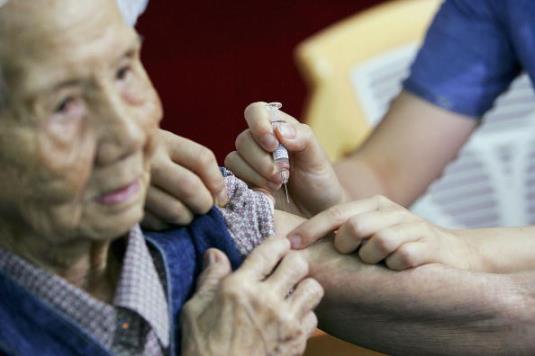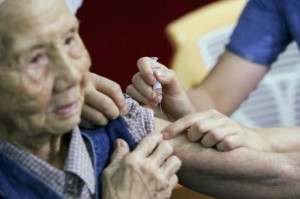
Imagine patient-centered care explained as a kind of updated Norman Rockwell painting. What you’d get is a recent PBS documentary, “Rx: The Quiet Revolution,” which, yes, uses a famous Rockwell image of a kindly family physician (Doctor and Doll) to set the stage for what follows.
Putting Patient-Centeredness into Practice
The 90-minute film, available for viewing online, features four extraordinary stories of inspiri ng healthcare providers working in Maine, Mississippi, Alaska and San Francisco. The film shows more than tells, following doctors and others as they put patient-centeredness into practice. You’ll want to go to those doctors. Or work with them. Or be them.
ng healthcare providers working in Maine, Mississippi, Alaska and San Francisco. The film shows more than tells, following doctors and others as they put patient-centeredness into practice. You’ll want to go to those doctors. Or work with them. Or be them.
The film also provides data on how this approach helps keep patients healthier and care costs down and its promise for changing care for all. Hence, the “Rx” and “revolution” in the film’s title.
What many Rockwell admirers don’t appreciate, however, is that his paintings were carefully composed, using models. “Quiet Revolution,” too, has a deliberate focus, promoting the power of compassion and communication. But real life is messier than even a Jackson Pollack, and those who metaphorically embrace patient engagement as a medication should consider that all therapies have their limits.
Meeting Patients Where They’re At
Dr. David Loxtercamp, puttering to house calls while perched on a red scooter, is the personification of the new patient-centered practitioner. Though the film never mentions socioeconomic status explicitly, it’s clear that many of Loxtercamp’s patients in the Belfast, Maine area are struggling. Loxtercamp is acutely aware of the stress in their lives and its link to unhealthy behaviors. He says:
“Their failure to be compliant – that’s a medical term for them not doing what I want them to do – may come for a lot of different reasons, most of which are exactly why they’re in the fix they’re in to begin with, why they’re diabetic, why they’re a smoker, why they’re overweight.”
We meet a woman so obese (She declares, “I hate scales; they’re my enemy.”) that she cannot travel to Loxtercamp’s office. The need to meet patients where they are, literally and figuratively, is why Loxtercamp makes house calls. His personalized approach is effective (Smoking cessation is up, emergency room are visits down.), but not necessarily for strictly medical reasons. He explains:
“The patients who are capable of eating the right food and getting exercise and doing all the right things, they really don’t need me. The challenge for me is with those patients who are complicated, who have difficult home circumstances, who have conflicts in their life. I may be the only person who talks to them with a friendly voice and cares about the outcome of something they’ve done. I want to help them get to that next step.”
One might ask: Is this a void to be filled by “person-centric” care, or is more needed?
Filling the Voids
 In the Mississippi Delta town of Ruleville, Annie Ford, an elderly black woman, relates how she got her diabetes under control with the help of the Center for Telehealth at the University of Mississippi in Jackson and the local Sunflower Health Clinic. She explains how the past has affected her present:
In the Mississippi Delta town of Ruleville, Annie Ford, an elderly black woman, relates how she got her diabetes under control with the help of the Center for Telehealth at the University of Mississippi in Jackson and the local Sunflower Health Clinic. She explains how the past has affected her present:
“For years, I had (diabetes) and didn’t know it. I didn’t know who to talk to, where to go…No one cared. I prayed.”
Dealing with diabetes is tough, telehealth center director Dr. Kristi Henderson says. “You’ve got to change your whole life.” Had the film chosen to portray it, we would have seen how extra difficult that can be in a place like Ruleville, part of a county that ranks 80th in per capita income of 82 counties in Mississippi, the poorest state in America. In rural Mississippi, places to buy healthy food are nearly as rare as doctors.
In Alaska, Katherine Gottlieb, president of an Alaska Native organization called Southcentral Foundation, remembers how Indian Health Service doctors once looked at her as if she weren’t there. Today, in what is called the Nuka System of Care, physician extenders in far-flung local clinics attend to their neighbors’ ailments and then connect via telehealth to a physician when necessary. The segment focuses on patient-centered care of traditional medical problems such as diabetes; it is jarring to hear at segment’s end that Alaska Natives rank sexual abuse and sexual assault as their biggest health concern.
Improving Choices, If not Circumstances
What the film wants us to see as the connection among all the healthcare professionals we meet is their commitment to caring, careful listening, teamwork, patient-centeredness that encompasses in-person outreach, and using technology. Unemphasized, but also true, is that they are often helping patients with little money and little education to improve their choices even if they cannot always improve their circumstances.
 The film’s final segment, featuring the On Lok Lifeways program in San Francisco, examines patients whose health vulnerability comes from aging and may be unavoidable. Nonetheless, caring and careful listening enable these elderly individuals, many living modestly in San Francisco’s Chinatown, to remain at home rather than in an expensive institutional setting.
The film’s final segment, featuring the On Lok Lifeways program in San Francisco, examines patients whose health vulnerability comes from aging and may be unavoidable. Nonetheless, caring and careful listening enable these elderly individuals, many living modestly in San Francisco’s Chinatown, to remain at home rather than in an expensive institutional setting.
Seeking a Genuine Partnership
The film was the idea of Dr. Jennifer Mieres, a cardiologist in Long Island. She and writer-director David Grubin, a veteran filmmaker, make clear they had specific goals. Mieres wanted to show that effective disease management requires a genuine partnership. That meant showing viewers “they need to be empowered partners in their health.”
Grubin, the son of a family doctor who practiced in New Jersey in the 1950s and 1960s, felt a personal tie to medicine. He said, “I loved the idea that this film was going to be about solutions… (and) wasn’t going to be another critique.”
It isn’t. The program’s lead funder is the American Medical Association (AMA), and in the opening minutes we see a black-and-white photo of Grubin as a young boy with his dad. We also see Doctor and Doll, which Grubin tell us his mother kept on her bureau because “it was her idea of what a doctor should be. Warm, empathetic….”
The Power of Community
That’s a wonderful ideal, and “Quiet Revolution” brings it to life in primary care in a vivid manner. Listen closely to the lessons these practitioners learned from their own listening and you’ll come away with important lessons about putting patient-centeredness into practice on the front lines of care. One of the most important is the power of community, be it a community of professionals that respect each other’s talents or a one where patients and clinicians share a common journey.
It’s unfortunate, then, that the film discretely avert its eyes from “culture of health” issues that arise from community dysfunctions rather than individual ones. Patient-centeredness alone cannot obviate the need to address the corrosive impact of disparities in timely access to safe, high-quality care.
An essay on Doctor and Doll in the AMA Journal of Ethics noted that Rockwell consciously set out to provide what some might call “a flight from engagement with complexity.” In other words, even in Rockwell’s era, the real lives of actual people were never that simple.




